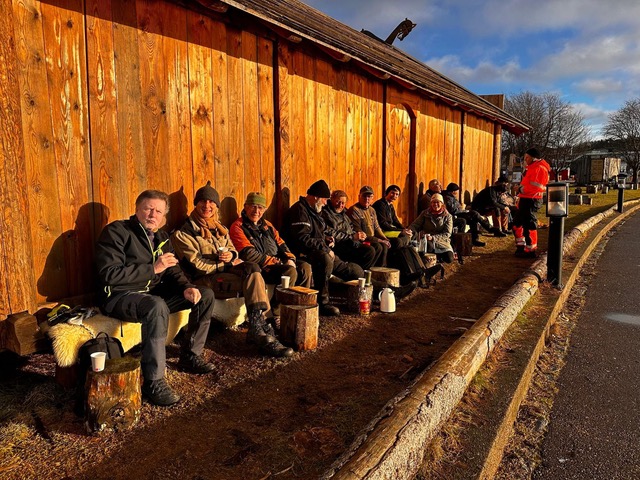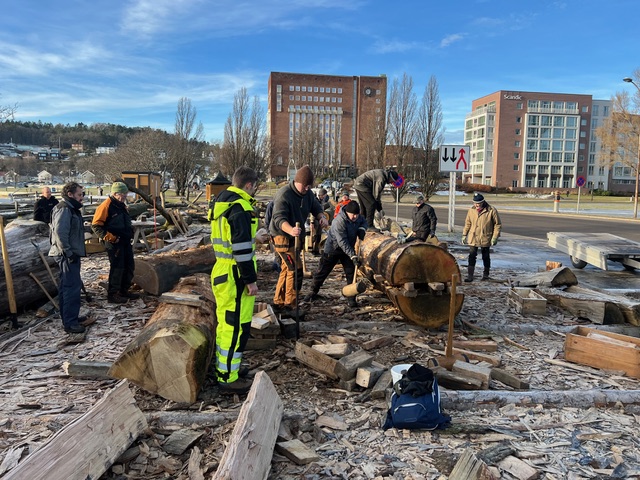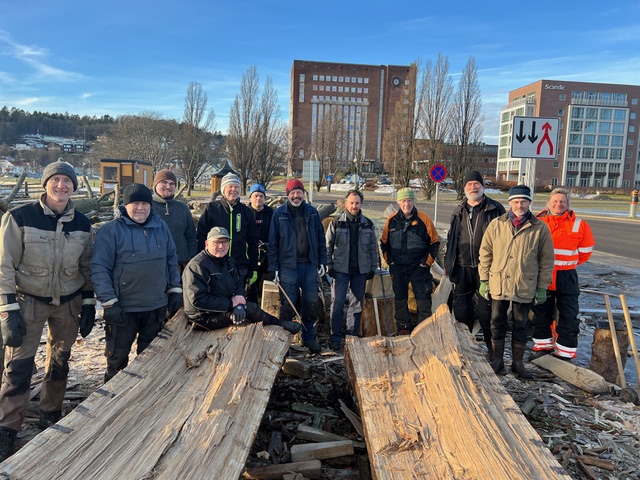In the park by the waterfront in downtown Sandefjord, you’ll meet a great group of people of all ages, radiating enthusiasm, curiosity, and eagerness. Here, you can smell fresh wood and hear the sound of axes at work. It’s the craft heritage of the Viking Age being recreated.
By Tore Forsberg

Traditional craftsmen have a strong passion for their craft and are determined to preserve the art for future generations. For them, craftsmanship is a way to express themselves creatively and pass on their culture to others. Their craft is often the result of years of training and dedication, and their greatest fear is that the knowledge will die out with their generation. Traditional craftsmanship is like a dance, expressed through the movements of tools and materials, resulting in a high-quality object.
This magic is happening publicly in the center of Sandefjord. Through a combination of traditional craft art, research, and volunteer efforts, the Gokstad ship is being reconstructed as authentically Viking Age as possible. This sets it apart from previous construction projects, as we are involving volunteers in the building process and have access to a park where everyone can come and participate in the entire process. Similar to the building of the Saga Oseberg (2010-2012), the work is being carried out in an almost authentic manner. Considering that the original Gokstad ship was also built locally, this holds even more significance for craftsmen, researchers, artists, and enthusiasts. The public will have the opportunity to be part of a unique historical event, as well as gain insight into how traditional craftsmanship is passed down to new generations. Here, Norway’s most important cultural heritage is safeguarded through research, learning processes, and documentation.
We are making history
In the fall of 2020, we set up camp at the seaside end of Badeparken in Sandefjord, with Park Hotel and the ocean as our nearest neighbors. This marked the beginning of a series of pre-research and research projects in collaboration between traditional craftsmen, researchers, and volunteers. Under the leadership of the Oseberg Viking Heritage Foundation, we are working with two national expert groups in forestry and wood use, NMBU and NIBIO in Ås. We also receive help from the cultural department of Vestfold County Municipality with digital registration. Additionally, a local membership association called Gokstad Byggelag has been founded.
Our main focus is to preserve traditional craft art through research and documentation at every stage. This includes everything from sourcing raw materials (selecting and felling trees) to storage, processing, and the finished product. The primary goal is not just a completed Gokstad ship but also the dissemination of knowledge about material selection and processing. This is an inclusive project that reconstructs the process, providing unique value for research.
It’s worth noting that the original Gokstad ship, discovered in Sandefjord, has been confirmed to have been built locally in the region. Most likely, the chieftain who was buried with the ship personally described how it should be built. This adds even greater historical and cultural significance to the process we are re-creating in Sandefjord.
Pre-project started in 2021
In 2022, we received approval for a qualification project titled “Qualification Project on the Development of Raw Material Documentation and Historical Techniques for Wood Processing.” The goal of the project is to lay the groundwork for larger research that explores the connection between raw material selection and wood processing techniques for building Viking ships. We are focusing on the inherent properties of wood, such as wood technology, timber quality, storage, and processing.
Before a three-day gathering, traditional craftsmen from Norway and Denmark, specializing in medieval and Viking techniques, were involved. During the gathering, craftsmen, researchers, and volunteers shared knowledge and experiences.
One of the most enthusiastic participants is Jon Bojer Godal, one of Norway’s foremost educators in traditional crafts. He has written numerous books on everything from traditional boat building to log house construction and survival techniques in Norwegian nature. He is passionate about passing on traditional craftsmanship to younger generations and was appointed Commander of the Order of St. Olav in 2015.
The traditional splitting techniques from Norway and Denmark (the Viking Ship Museum in Roskilde) are very different. We have a close collaboration with Jon and several others in traditional craft communities in Norway who participated in our gathering to develop shared knowledge about oak splitting. It’s worth noting that this specialized practice is only carried out in Sandefjord and Roskilde.
When building a Viking ship, axes are used; saws hadn’t been invented at that time. In NRK2’s podcast “Drivkraft,” Jon explained that the boatbuilder was not allowed to sign their name on the boat. The boat belonged to a higher objectivity; it was not “you as a person” but the boat as a common good that mattered. A common good should not be tarnished by putting your name on it. This is the complete opposite of other works of art. Passing on traditional craftsmanship is a way of honoring the “nameless.” There is so much experience and love embedded in the work they performed.
Oak splitting
The main topic of our first gathering was oak splitting—how to do it in the best possible way.
Together, we described the various splitting methods used in the past, tested the methods, and documented the results. The purpose of our research is to determine which splitting methods provide the best utilization of the timber and the highest quality in the final product. This is especially important for boatbuilders, where we see that the yield from the logs is surprisingly low. We want to find out if it’s possible to increase the yield by improving the raw material and/or the splitting method.

Additionally, we aim to contribute to better resource access and increased knowledge of nature, which will be made available for teaching elementary school students, focusing on educating children and young adults. This way, we can help strengthen the understanding and interest in traditional craftsmanship and the sustainable use of natural resources among future generations. The project will establish a research strategy and structure around the craft, allowing us to create a knowledge base around this and other traditional crafts.
The purpose of the qualification project was thus to compare splitting from the root-end (bottom), top, and side—to determine if one of these is better than the others. Logs with a diameter of 1 meter and a length of 3–6 meters were split down to finished plank blanks (1/8).
Splitting can be described in five steps:
- Selection of timber in the forest/field
- Each root log is split into two halves, divided into bottom, top, and side splitting
- Each half is split into quarters, randomly divided into bottom, top, and side splitting
- Each quarter—the pith is removed, and splitting continues based on the same assessment as above
- Processing into ship planks (axe hewing) or further splitting (if needed)
We delved into several concepts related to splitting, including stave splitting. The method produces plank blanks where the surfaces follow the grain, both along the length and the medullary rays. One can see “mirrors” in the surface of the finished boards, especially in the medullary rays of the oak. The method is usually used for shorter plank blanks for shingles and staves but also for ship planks where it’s important to avoid grain breakage.
It’s important that those who will work on the splitting are involved in selecting the trees in the forest; otherwise, they may miss out on the knowledge potential that a standing tree can offer.
Wood storage
Traditionally, oak timber is split when green, so long-term storage has little effect on splitting. When it comes to pine, the timber should be felled as close to the splitting process as possible to avoid end cracks. If storage is necessary, no more than 2–3 weeks should pass between felling and splitting.
Moistening the wood
This was not relevant for oak logs in the project. However, if bent boards are needed, moistening can be helpful.
Splitting and processing
This is part of ongoing research. We are inviting other disciplines from industry to learn from the traditional techniques we are practicing.

Join in and make history
Now that you’ve gained some insight into the work happening in Badeparken, it’s important to take a moment to appreciate and celebrate the effort being made to pass on and recreate knowledge of our shared cultural heritage. Artists, researchers, and volunteers are working together to recreate authentic Viking Age craftsmanship. Through this unique work, traditions are being kept alive for future generations. Everyone is invited to participate. You can do so by visiting our sites in either Sandefjord or Tønsberg, or contact via Email tore@manuelthandverk.no (Sandefjord) or janvogtknutsen@gmail.com (Tønsberg).
The project we are working on is highly ambitious. For the first time since the Viking Age, we are building this Gokstad ship as authentically as possible, based on our current knowledge. Experts, volunteers, and the general public are invited to participate, with a focus on research and local history.
The ship when finished will be operated in Sandefjord, and we are benefiting from the expertise in Tønsberg as part of the project. However, it is, and will remain, a Sandefjord project, provided we continue to receive support from the municipality and other local actors, so we can continue building and researching.
There is no doubt that this journey is important for all of us and that it can teach us a lot about ourselves and our history. Let’s invite family, friends, and colleagues to be part of this unique project, and let’s be inspired together by this blend of art, science, and history.
As we stand here in Badeparken, surrounded by the creative energy and dedication of all involved, we are reminded that we are not only honoring the past but also building bridges to a future where knowledge, passion, and collaboration are at the center. This journey is more than a celebration of our history; it’s a reminder of the importance of preserving and passing on our traditions so they can live on for countless generations.
Join us in seizing this historical opportunities to create something exceptional out of the sensational ship we have in our city.

